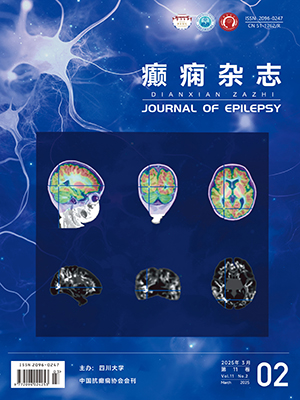| 1. |
Zaccara G, Perucca E. Interactions between antiepileptic drugs, and between antiepileptic drugs and other drugs. Epileptic Disord, 2014, 16(4):409-431.
|
| 2. |
刘晓燕.临床脑电图学.北京:人民卫生出版社, 2006:1-664.
|
| 3. |
Fisher RS, Acevedo C, Arzimanoglou A, et al. ILAE official report:a practical clinical definition of epilepsy. Epilepsia, 2014, 55(4):475-482.
|
| 4. |
Neligan A, Hauser WA, Sander JW. The epidemiology of the epilepsies. Handbook of Clinical Neurology, 2012, 107:113-133.
|
| 5. |
Cleary P, Shorvon S, Tallis R. Late-onset seizures as a predictor of subsequent stroke. Lancet, 2004, 363(9416):1184-1186.
|
| 6. |
Ryvlin P, Montavont A, Nighoghossian N. Optimizing therapy of seizures in stroke patients. Neurology, 2006, 67(12 Suppl 4):3-9.
|
| 7. |
Rosengart AJ, Huo JD, Tolentino J, et al. Outcome in patients with subarachnoid hemorrhage treated with antiepileptic drugs. Journal of Neurosurgery, 2007, 107(2):253-260.
|
| 8. |
Reddig RT, Nixdorf KE, Jensen MB. The prophylactic use of an antiepileptic drug in intracerebral hemorrhage. Clinical Neurology and Neurosurgery, 2011, 113(10):895-897.
|
| 9. |
Kwan J, Wood E. Antiepileptic drugs for the primary and secondary prevention of seizures after stroke. The Cochrane database of systematic reviews, 2010, 1):CD005398.
|
| 10. |
Marson A, Jacoby A, Johnson A, et al. Immediate versus deferred antiepileptic drug treatment for early epilepsy and single seizures:a randomised controlled trial. Lancet, 2005, 365(9476):2007-2013.
|
| 11. |
Randomized clinical trial on the efficacy of antiepileptic drugs in reducing the risk of relapse after a first unprovoked tonic-clonic seizure. First Seizure Trial Group (FIR.S.T. Group). Neurology, 1993, 43(3 Pt 1):478-483.
|
| 12. |
Hamer HM. Seizures and epilepsies after stroke. Der Nervenarzt, 2009, 80(4):405-414.
|
| 13. |
Menon B, Shorvon SD. Ischaemic stroke in adults and epilepsy. Epilepsy Research, 2009, 87(1):1-11.
|
| 14. |
Bladin CF, Alexandrov AV, Bellavance A, et al. Seizures after stroke:a prospective multicenter study. Archives of Neurology, 2000, 57(11):1617-1622.
|
| 15. |
De Lorenzo RJ, Sun DA, Blair RE, et al. An in vitro model of stroke-induced epilepsy:elucidation of the roles of glutamate and calcium in the induction and maintenance of stroke-induced epileptogenesis. International Review of Neurobiology, 2007, 81(7):59-84.
|
| 16. |
Nunes VD, Sawyer L, Neilson J, et al. Diagnosis and management of the epilepsies in adults and children:summary of updated NICE guidance. BMJ, 2012, 344:e281.
|
| 17. |
Beghi E, Carpio A, Forsgren L, et al. Recommendation for a definition of acute symptomatic seizure. Epilepsia, 2010, 51(4):671-675.
|
| 18. |
Zhang C, Wang X, Wang Y, et al. Risk factors for post-stroke seizures:a systematic review and meta-analysis. Epilepsy Research, 2014, 108(10):1806-1816.
|
| 19. |
Pezzini A, Grassi M, Del Zotto E, et al. Complications of acute stroke and the occurrence of early seizures. Cerebrovascular Diseases, 2013, 35(5):444-450.
|
| 20. |
Jungehulsing GJ, Heuschmann PU, Holtkamp M, et al. Incidence and predictors of post-stroke epilepsy. Acta Neurologica Scandinavica, 2013, 127(6):427-430.
|




